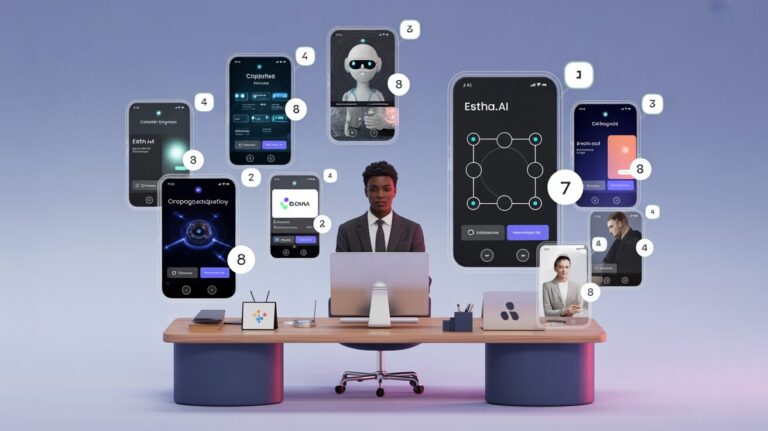Table Of Contents
- Introduction
- What Is a GPT-Powered App Builder?
- Key Features to Look for in GPT-Powered App Builders
- Top GPT-Powered App Builders Compared
- Transformative Use Cases for GPT-Powered Apps
- Choosing the Right Platform for Your Needs
- Conclusion: The Future of No-Code AI App Development
The artificial intelligence revolution has democratized software development in ways previously unimaginable. At the forefront of this transformation are GPT-powered app builders—platforms that harness the intelligence of large language models to enable anyone, regardless of technical background, to create sophisticated applications. These innovative tools are breaking down the traditional barriers to software development, allowing professionals across industries to transform their expertise into functional, intelligent applications.
Whether you’re a content creator looking to build an interactive learning tool, a small business owner seeking to automate customer service, or a healthcare professional wanting to develop a specialized diagnostic assistant, GPT-powered app builders provide the framework to turn these ideas into reality—without writing a single line of code.
In this comprehensive guide, we’ll explore the leading GPT-powered app building platforms available today, compare their features, capabilities, and limitations, and help you determine which solution best aligns with your specific needs. We’ll pay particular attention to user experience, customization options, integration capabilities, and the balance between simplicity and power that makes these platforms truly revolutionary.
GPT-Powered App Builders Compared
Finding Your Perfect No-Code AI Solution
What Makes a Great GPT App Builder?
Intuitive Interface
No coding knowledge required with visual building tools
Customization Depth
Balance between simplicity and powerful customization options
AI Model Quality
Advanced controls for fine-tuning model behavior and responses
Top Platforms Comparison
| Platform | Best For | Key Strengths |
|---|---|---|
| Estha | Content creators, educators, small business owners, healthcare professionals | 5-10 minute app creation, intuitive drag-drop-link interface, complete ecosystem support |
| Glide Apps | Small to medium businesses with structured data | Spreadsheet-based development, strong data handling, business-focused features |
| Adalo | Designers, entrepreneurs with UI focus | Visual interface design, hybrid AI integration, traditional app functionality |
| Bubble | Technical entrepreneurs, complex applications | Powerful workflow creation, extensive customization, complex database structures |
| GPT4Apps | Users focused on direct AI control | Direct OpenAI model access, conversational applications, prompt engineering |
Popular Use Cases
- Interactive Learning Tools – Adaptive tutoring and personalized education
- Knowledge Base Assistants – Making organizational knowledge accessible
- Customer Service Chatbots – Handling inquiries and recommendations
- Healthcare Support – Patient education and symptom assessment
- Content Creation Assistants – Ideation, drafting, and optimization
Choosing the Right Platform
Technical Comfort Level – Be honest about your skills
Application Purpose – AI-driven or AI-enhanced?
Integration Needs – Connections with existing systems
Scalability Requirements – Future growth plans
Prototype Testing – Try before committing
Why Estha Stands Out
Speed to Creation
Build fully functional AI apps in just 5-10 minutes
Complete Ecosystem
EsthaLEARN, EsthaLAUNCH, and EsthaeSHARE support
Accessible to Everyone
No coding or prompting knowledge required
Ready to create your own AI application?
What Is a GPT-Powered App Builder?
A GPT-powered app builder is a platform that combines the natural language processing capabilities of Generative Pre-trained Transformer (GPT) models with user-friendly interfaces that enable non-developers to create functional applications. These platforms essentially serve as intermediaries between complex AI technologies and end-users, providing intuitive tools that translate ideas into working software without requiring coding knowledge.
At their core, these platforms leverage GPT’s ability to understand and generate human-like text, make contextual connections, and perform various language-based tasks. When integrated into app building environments, these capabilities allow users to create applications that can engage in conversations, answer questions, generate content, analyze information, and make recommendations—all based on the specific knowledge and parameters defined by the creator.
The revolutionary aspect of these platforms is their accessibility. Traditional app development requires expertise in programming languages, database management, UI/UX design, and deployment processes. GPT-powered app builders abstract away these technical complexities, replacing them with visual interfaces, drag-and-drop components, and natural language inputs that anyone can understand and utilize.
This democratization of app development represents a significant shift in how we think about software creation, moving it from the exclusive domain of developers and engineers to a creative tool accessible to professionals across all fields. The result is a new ecosystem where specialized knowledge from any discipline can be captured, enhanced, and distributed through custom applications.
Key Features to Look for in GPT-Powered App Builders
When evaluating GPT-powered app building platforms, several critical features distinguish the truly transformative solutions from the merely adequate ones. Understanding these key elements will help you select a platform that not only meets your immediate needs but can also grow with your ambitions.
Intuitive Interface and Low Learning Curve
The primary purpose of these platforms is to make app creation accessible to non-developers. Therefore, the interface should be intuitive, with clear visual cues, logical workflows, and comprehensive but unobtrusive guidance. The best platforms allow users to start building immediately, learning as they go rather than requiring extensive tutorials before any progress can be made.
Customization Depth
While simplicity is important, the platform should not sacrifice depth of customization. Look for solutions that offer multiple layers of configuration—from simple adjustments anyone can make to more advanced options for those who want to fine-tune their applications. The ability to customize both the functionality and appearance of your app ensures it truly reflects your vision and brand.
AI Model Quality and Control
The underlying GPT model is the engine that powers your application’s intelligence. Platforms should offer access to current, capable AI models with controls for adjusting parameters like creativity, response length, and topic focus. Additionally, the ability to train or fine-tune the model on your specific knowledge domain dramatically increases the value and accuracy of your application.
Integration Capabilities
Few applications exist in isolation. The best GPT-powered app builders offer robust integration with other tools and data sources, allowing your AI application to connect with existing systems, access up-to-date information, and become part of your broader digital ecosystem. Look for platforms with pre-built connectors to popular services and APIs for custom integrations.
Deployment Flexibility
Once created, you need options for sharing your application with users. Superior platforms offer multiple deployment options, including web embedding, standalone websites, mobile compatibility, and sometimes even native app generation. The ability to easily update your application after deployment is also crucial for maintaining relevance and functionality.
Scalability and Performance
As your application gains users, the platform should scale seamlessly to handle increased traffic without performance degradation. This includes both the responsiveness of the application itself and the reliability of the AI components. Platforms that offer tiered performance plans allow you to start small and expand resources as your needs grow.
Monetization Options
For those looking to generate revenue from their applications, built-in monetization tools are invaluable. These might include subscription management, payment processing, content gating, or marketplace integration. The more flexible these options, the more business models your application can support.
Top GPT-Powered App Builders Compared
The market for GPT-powered app builders has expanded rapidly, with several platforms offering distinctive approaches to no-code AI application development. Here’s a detailed comparison of the leading solutions, highlighting their strengths, limitations, and ideal use cases.
Estha: The Revolutionary No-Code AI Platform
Overview:Estha stands out as a truly revolutionary no-code AI platform designed specifically for non-technical users who want to create sophisticated AI applications without any coding or prompting knowledge. What sets Estha apart is its intuitive drag-drop-link interface that simplifies complex AI implementation into a visual process anyone can master.
Key Strengths:
Estha’s interface eliminates the typical learning curve associated with AI application development. Users can build fully functional AI applications in just 5-10 minutes through an intuitive process that feels more like arranging ideas than programming. The platform excels at translating domain expertise into interactive applications, making it ideal for professionals who are experts in their field but have no technical background.
The ecosystem approach is another significant advantage, with Estha providing a complete suite of supporting services through EsthaLEARN (education), EsthaLAUNCH (scaling resources), and EsthaeSHARE (monetization and distribution). This comprehensive approach ensures users aren’t just building apps but are supported through the entire lifecycle from learning to earning.
Best For: Estha is particularly well-suited for content creators, educators, small business owners, and healthcare professionals who want to quickly transform their expertise into interactive AI tools without technical barriers. The platform excels at creating chatbots, expert advisors, interactive quizzes, and virtual assistants that authentically reflect the creator’s knowledge and brand voice.
Limitations: As a newer platform focusing on accessibility, Estha may not yet offer the breadth of integration options that some enterprise users might require. However, its rapid development cycle suggests these capabilities will expand quickly.
Pricing: Estha offers flexible pricing options that make AI app creation accessible to individuals and businesses of all sizes, with a free tier for basic exploration and premium options for more advanced features and higher usage volumes.
Glide Apps: Business-Focused App Creation
Overview: Glide is a no-code platform that allows users to create apps from spreadsheets and has recently expanded to incorporate AI capabilities through their Glide AI feature set.
Key Strengths:
Glide’s foundation in spreadsheet-based app development makes it exceptionally strong for data-driven applications. Their business focus has resulted in robust features for creating operational tools like inventory management, CRM systems, and logistics applications. The platform offers strong integration with Google Sheets and other data sources, making it suitable for teams already working with structured data.
Their AI implementation focuses on practical business use cases like invoice processing, resume screening, and contract management, indicating a utilitarian approach to AI rather than a conversational one.
Best For: Small to medium businesses looking to create operational tools with some AI augmentation. Glide works well for teams that already organize their data in spreadsheets and want to transform that data into functional applications.
Limitations: Glide’s AI capabilities appear more templated and less flexible than some alternatives. The platform is less suited for creating highly conversational or knowledge-based AI applications compared to purpose-built AI platforms like Estha.
Pricing: Glide offers tiered pricing based on users, features, and support levels, with business-oriented packages that can become relatively expensive for larger deployments.
Adalo: Visual App Building with AI Integration
Overview: Adalo is primarily a visual app builder that has begun incorporating AI features, offering a middle ground between traditional app development and AI-focused platforms.
Key Strengths:
Adalo’s visual interface for creating mobile and web applications is mature and refined, making it easy to design polished user interfaces. Their recent AI integrations allow developers to incorporate GPT-powered features within traditionally structured applications. This hybrid approach benefits users who need conventional app functionality enhanced with AI capabilities rather than AI-first applications.
Best For: Designers and entrepreneurs who prioritize visual customization and traditional app functionality but want to incorporate some AI features. Adalo works well for projects where the AI component is a feature rather than the core of the application.
Limitations: Adalo’s AI implementation is less central to their platform and more of an add-on feature, making it less powerful for purely AI-driven applications. The learning curve is steeper than dedicated no-code AI platforms like Estha.
Pricing: Adalo uses a tiered pricing model based on the number of apps, records, and active users, with separate charges for some premium features including AI integrations.
Bubble: Comprehensive Web App Development
Overview: Bubble is a powerful no-code platform for web application development that has added GPT integration capabilities, offering extensive customization but with a steeper learning curve.
Key Strengths:
Bubble offers unparalleled flexibility in no-code web application development, with their AI plugin system allowing developers to incorporate GPT capabilities. The platform excels at creating complex workflows and database structures, making it suitable for sophisticated applications that require both AI and conventional functionality.
For users willing to invest time in learning the platform, Bubble offers perhaps the most complete set of tools for creating web applications with integrated AI features.
Best For: Technically-inclined entrepreneurs and businesses looking to build complex web applications with AI components. Bubble is ideal when you need both conventional application logic and AI capabilities in a single platform.
Limitations: Bubble has a significant learning curve compared to dedicated AI app builders like Estha. The AI implementation requires more technical configuration, making it less accessible to non-technical users. Mobile deployment options are also more limited.
Pricing: Bubble’s pricing structure is based on server capacity, features, and support levels, becoming quite expensive for applications with higher traffic or more complex requirements.
GPT4Apps: Direct OpenAI Integration
Overview: GPT4Apps offers a more direct approach to building with OpenAI’s models, providing a streamlined interface specifically for creating applications powered by GPT-4 and other OpenAI technologies.
Key Strengths:
GPT4Apps provides more direct access to OpenAI’s models with fewer abstractions, which can be advantageous for users who want fine-grained control over the AI aspects of their applications. The platform specializes in conversational applications and content generation tools, with strong features for prompt engineering and context management.
Best For: Users with some technical background who want to focus specifically on the AI capabilities of their applications rather than complex interfaces or workflows. The platform works well for conversational agents, content generators, and knowledge-based applications.
Limitations: GPT4Apps offers less comprehensive tools for user interface design and general application functionality compared to broader platforms. The focus on AI sometimes comes at the expense of easy integration with other systems or data sources.
Pricing: Typically based on API usage and model access, with costs scaling according to the volume of AI interactions and the specific models utilized.
Transformative Use Cases for GPT-Powered Apps
The versatility of GPT-powered app builders has enabled innovation across numerous industries and use cases. Here are some of the most impactful applications being developed on these platforms:
Interactive Learning Experiences
Educators are using platforms like Estha to create personalized learning tools that adapt to each student’s pace and learning style. These applications can simulate tutoring sessions, provide instant feedback on assignments, generate customized practice problems, and explain complex concepts in accessible language. The ability to have natural, back-and-forth conversations with these educational tools creates an engaging experience that traditional e-learning often lacks.
Knowledge Base Assistants
Organizations with large repositories of internal knowledge are building AI assistants that make this information accessible and actionable. These applications can answer questions about company policies, technical specifications, procedural details, or historical data—all while maintaining the context of the conversation. Unlike traditional search tools, these assistants can synthesize information from multiple sources, explain relationships between concepts, and present information in the most relevant format for the user’s needs.
Customer Service Automation
Small businesses are implementing sophisticated customer service chatbots that handle inquiries, process simple transactions, and provide product recommendations. These applications can be trained on specific product catalogs, service offerings, and company policies to provide accurate, helpful responses that reflect the business’s voice and values. The reduction in response time and the ability to handle multiple inquiries simultaneously create significant operational efficiencies.
Healthcare Support Tools
Healthcare professionals are developing specialized applications that help with patient education, symptom assessment, and treatment adherence. These tools can explain medical conditions in layperson’s terms, guide patients through pre-appointment questionnaires, or provide reminders and instructions for medication regimens. By creating these applications without code, healthcare providers can rapidly deploy digital tools that extend their reach and effectiveness.
Content Creation Assistants
Content creators across media are building AI tools that assist with ideation, drafting, editing, and optimization. These applications can suggest topics based on trending interests, generate outlines for articles or videos, provide feedback on draft content, or optimize finished pieces for specific platforms or audiences. The collaborative nature of these tools enhances human creativity rather than replacing it.
Choosing the Right Platform for Your Needs
Selecting the optimal GPT-powered app builder depends on your specific requirements, technical background, and project goals. Here’s a framework to guide your decision-making process:
Assess Your Technical Comfort Level
Be honest about your technical capabilities and how much time you’re willing to invest in learning a new platform. If you have no coding background and want to create something quickly, platforms with highly visual interfaces like Estha offer the lowest barriers to entry. If you’re comfortable with more technical concepts and want greater customization power, platforms like Bubble might be worth the steeper learning curve.
Define Your Application’s Core Purpose
Identify whether your application is primarily AI-driven (like a conversational assistant or knowledge tool) or whether the AI components are supplementary to more traditional functionality (like a business application with some AI features). For AI-centric applications, dedicated platforms like Estha typically offer superior capabilities and easier implementation. For applications where AI is just one component, hybrid platforms may provide better overall functionality.
Consider Integration Requirements
If your application needs to connect with existing systems, databases, or third-party services, evaluate each platform’s integration capabilities carefully. Some platforms offer extensive pre-built connections, while others may require more complex setups or have limitations on external data access.
Evaluate Long-term Scalability
Consider how your application might grow over time in terms of users, functionality, and data volume. Platforms with tiered pricing based on usage can become expensive as you scale, while others might impose technical limitations that affect performance as user numbers increase. Look for platforms that offer clear upgrade paths and transparent pricing for growth scenarios.
Test with Prototyping
Most platforms offer free trials or limited free tiers that allow you to build prototype applications. Take advantage of these opportunities to test how different platforms handle your specific use case before committing. Pay particular attention to the quality of AI responses, the fluidity of the building experience, and how closely the finished product matches your vision.
For most non-technical users seeking to create AI-powered applications quickly and effectively, Estha offers the optimal balance of accessibility, functionality, and support. Its focus on transforming domain expertise into interactive AI applications without technical barriers makes it particularly valuable for professionals who want to share their knowledge through technology.
Conclusion: The Future of No-Code AI App Development
The emergence of GPT-powered app builders represents more than just a technological advancement—it signals a fundamental shift in who can create software and how that software serves specialized knowledge domains. These platforms are democratizing application development in ways that parallel how word processors once democratized publishing or how social media democratized content distribution.
As these tools continue to evolve, we can expect even greater accessibility, more sophisticated AI capabilities, and deeper integration options that will further reduce the barriers between idea and implementation. The distinction between “developers” and “users” will continue to blur, creating new opportunities for innovation from previously untapped sources of expertise.
For individuals and organizations looking to leverage AI in their work, the message is clear: you no longer need to wait for someone else to build the application you need. With platforms like Estha leading the way in making AI application development truly accessible to everyone, the power to create sophisticated, intelligent software is now in your hands.
The most exciting aspect of this revolution is not just what these platforms can do today, but what they will enable tomorrow as more diverse voices and perspectives gain the ability to create technology that reflects their unique knowledge and vision. As barriers continue to fall, we can look forward to a richer, more varied software ecosystem that better serves the full spectrum of human needs and interests.
Ready to Create Your Own AI Application?
Turn your expertise into an interactive AI app in minutes, no coding required. Join thousands of professionals who are building with Estha today.



